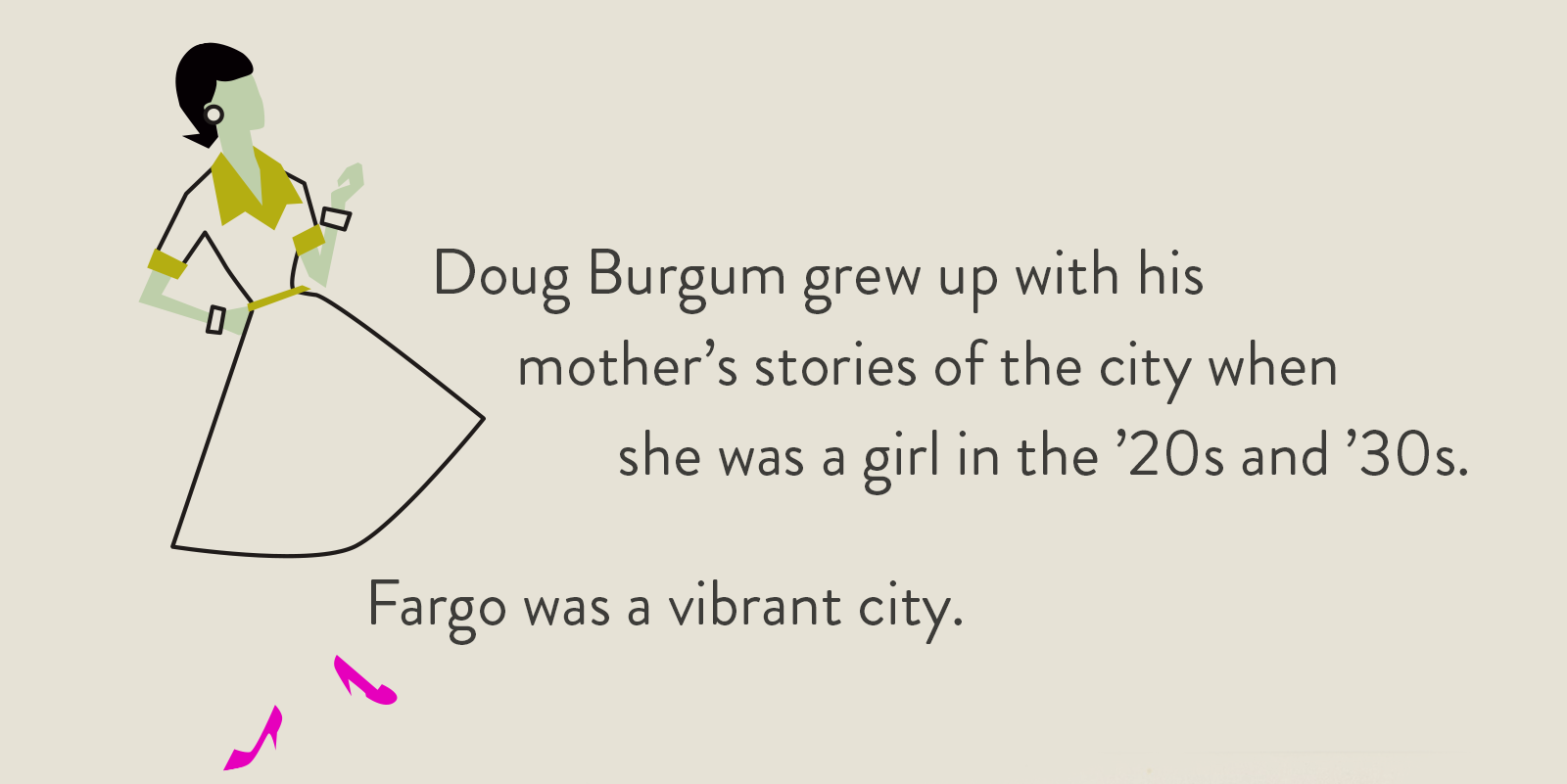

Back then, Fargo had a trolley that ran down the center of town. Most people either didn’t have a car, or they used it sparingly.
People walked.
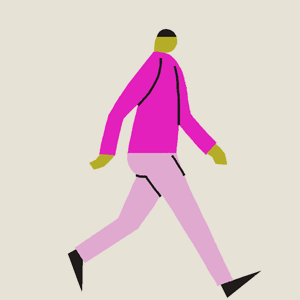
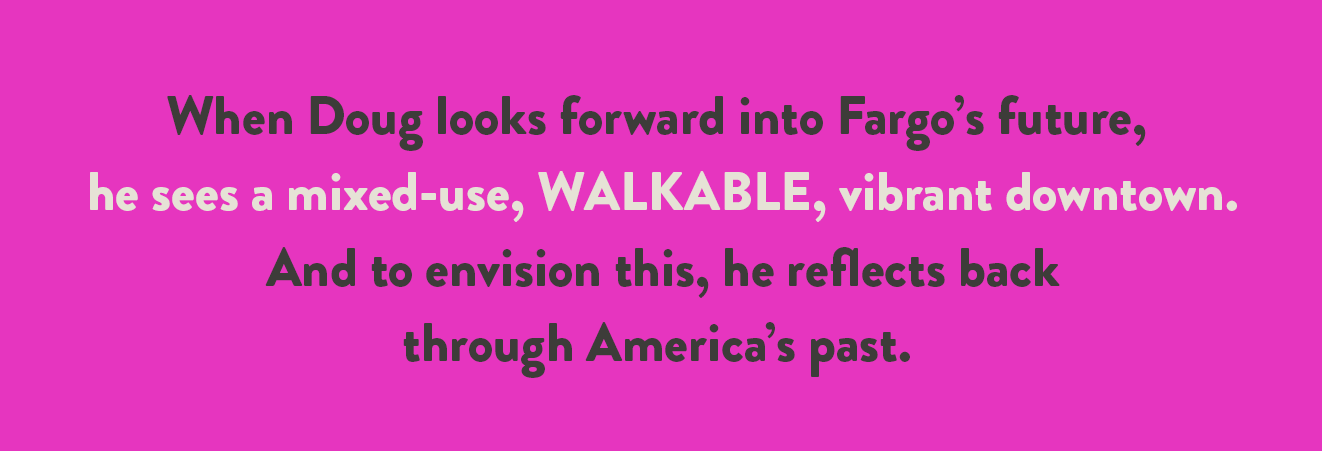

Post-World War II, America’s obsession with the automobile boomed. The government invested in federal highway traffic funds and bestowed subsidies to the U.S. auto industry. Whole cities shifted and were redesigned to meet the demands of a car-crazy culture.


By the time Doug was a young man and living in Chicago, the city of Fargo went into decline. People fled. Historic downtown buildings were shuttered. Doug was distraught. “Fargo was dilapidated,” he says. “It was a shadow of its former self.” Still, he was grateful to have grown up in North Dakota. He wanted to build a business there.
“That’s the story of a lot of entrepreneurs in small towns in North Dakota — to build something in a place where everybody told us we couldn’t,” Doug says.

In 1983 he took bold action: he returned to North Dakota and joined Great Plains Software, then a small startup company in the emerging computer software industry. The move stemmed in part from his love of his home state, which was where he wanted to raise his family. He also liked the challenge of building a software company in an area without the words “silicon” or “valley” in it.
Doug served as the CEO of Great Plains Software and led it through a period of rapid growth. He wanted to do things his way, by investing in top — often young — talent and making them feel valued. He did things that were considered unconventional. He would often call employees’ parents to convince them their children weren’t making huge mistakes by working at a small software company instead of in accounting or finance. He nurtured people and careers.
It worked. Great Plains Software was sold in 2000 to Microsoft, which continues to be a major employer in the area to this day. And Doug’s vision of Fargo as a high-tech hub came to fruition. Today there are more than two dozen technology companies in the Fargo-Moorhead area, including John Deere Electronic Solutions and Myriad Mobile. Doug was an early believer in software’s profound potential.
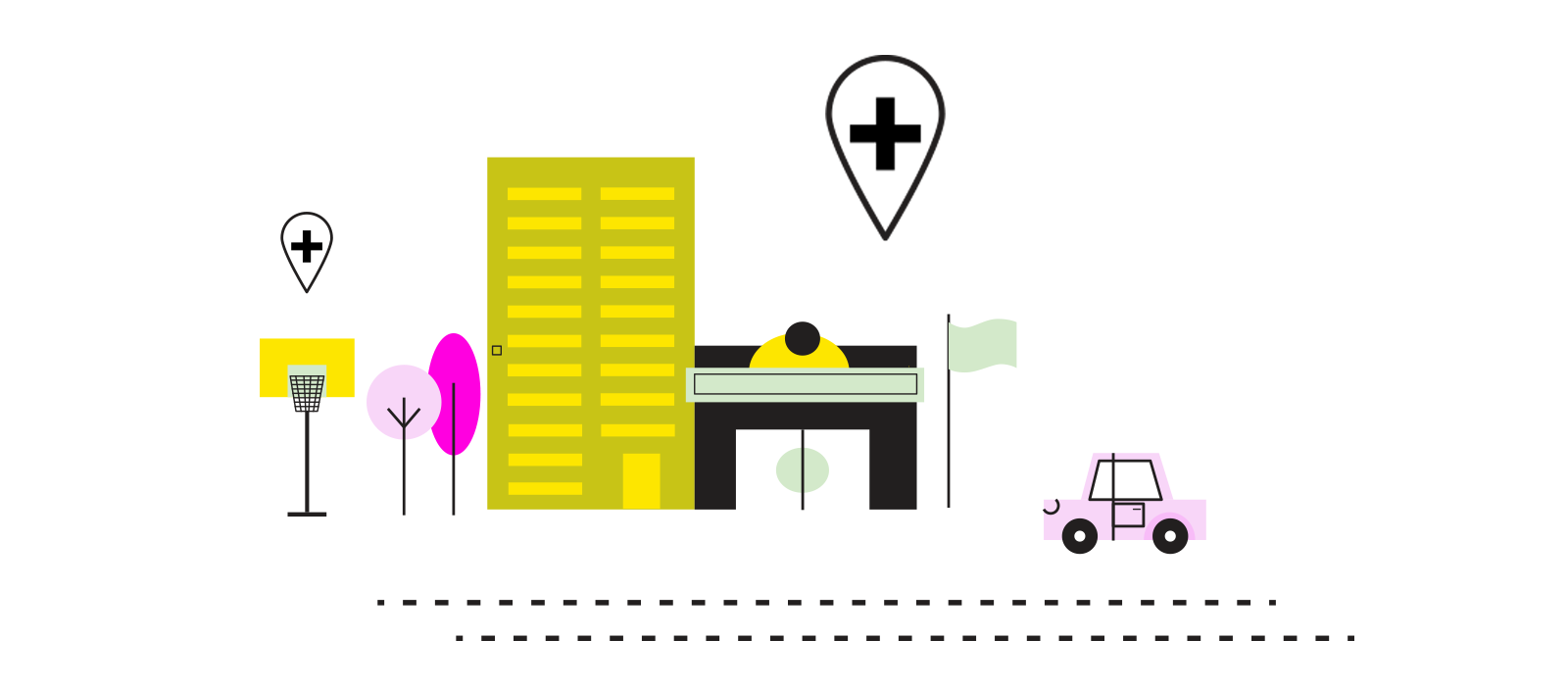 When Doug sees potential, he moves quickly.
When Doug sees potential, he moves quickly.
At first, Doug wanted to invest in downtown Fargo because of a love for the architecture. But he soon shifted from the sense of wanting to save old buildings to a deeper understanding of how urban design can impact a community’s health and vitality. He was captivated by the economics behind it all, and specifically how a revitalized downtown might recruit a workforce.
“I’ve developed a really strong point of view that vibrant downtowns create smart, healthy cities.”
So Doug turned from software to hardware and pivoted to his next priority: starting the Kilbourne Group and giving it a mission of revitalizing downtown Fargo, one restoration and construction project at a time.
The organization started strong out of the gates. “The first building I got involved in was one where I got paid to take it,” he says.
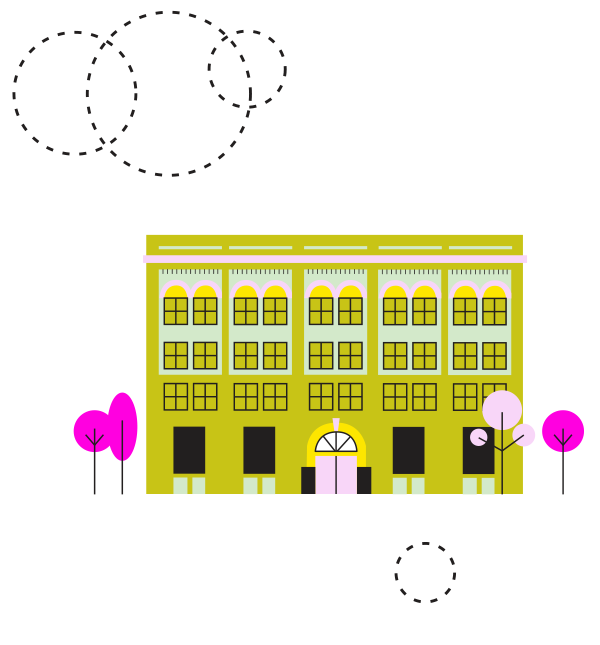
That was the Northern School Supply Building. It was beautiful and had potential, but it was falling apart and had no buyers. In fact, the city was going to spend a quarter million dollars to knock it down. Doug had a better offer. Pay us $100,000 to absorb the environmental liability and renovate it. Deal. Not only did the Kilbourne Group renovate the building, but they also donated it to the NDSU Development Foundation and secured federal grant funds and tax credits. The building is now part of the University’s downtown campus, housing parts of the visual arts and architecture departments. It was aptly renamed Renaissance Hall in 2008.
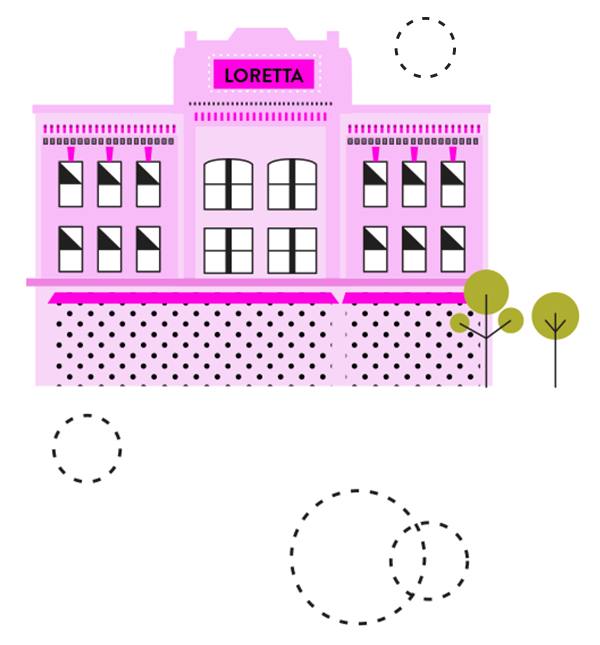
The Loretta Building was one of Kilbourne Group’s next projects. A lovely five-story brick and wood structure on Broadway, it was under-utilized for decades. Before its renovation the building had just two retailers and six employees. The upper floors didn’t have fire-rated stairwells or sprinkler systems and so couldn’t be used. And don’t even ask about the basement.
Today, thanks to Doug and his team, there are 20 businesses and 120 employees operating out of the Loretta Building. There’s 48,000 square feet of usable space, an upgrade over the prior 9,000, and the basement is in use with a coffee shop and a bar. None of this took much in the way of city resources. “Fargo didn’t have to build any new feet of sidewalk or add additional sewer water or garbage routes,” Doug says.
 Doug stands behind Fargo’s aim to build a reputation as a creative capital. He looks to Minneapolis, Austin, and Portland as examples of mid-size cities attracting and retaining young people. And why not Fargo? With Minneapolis losing more of its population to Fargo than any other city last year, it looks like the city is on its way.
Doug stands behind Fargo’s aim to build a reputation as a creative capital. He looks to Minneapolis, Austin, and Portland as examples of mid-size cities attracting and retaining young people. And why not Fargo? With Minneapolis losing more of its population to Fargo than any other city last year, it looks like the city is on its way.
“We have 30,000 students here, and in the past they’d all leave after graduating,” he says. “Now, we’re giving them a reason to stay. And we need them to stay. We have more than 24,000 jobs in North Dakota right now, 6,500 in the Fargo metro area. We need these young people to stick around — and they are, because the city aligns with their values.”

When Doug talks about what recent graduates value, he’s talking mostly about walkability. That’s the primary, ahem, driver for much of Doug’s vision, as he follows the data that says young people prefer walking and biking over driving. Three in four Millennials (surveyed by The Rockefeller Foundation and Transportation for America) said they want to live in places where they don’t need a car to get around. “Millennials grew up in car seats and they don’t want to spend their life in cars,” he says. And in terms of walkability, downtown Fargo shines. It’s earned a 96 from walkscore.com, which the site rates as “Very Walkable.”
There’s also a tangible social health benefit to encouraging all this walking. It will lower healthcare costs. “We spend almost three trillion dollars on healthcare in America. Over forty percent of that is for the baby boomer and older generations, the generations that walked less than any generations ever,” Doug says. “A lot of that cost goes to people with chronic diseases like diabetes and heart-related stuff, all which can be solved not by a gym membership but by just walking more. I believe that like the sun is coming up.”
The sun is shining brightly on Fargo today, and Doug insists the city is just beginning to realize its full potential.
“We’ve done a nice job in this phase of improving the economics and doing historic renovations and adaptive re-use. But at some point there are no more historic buildings to renovate. What’s next is to keep adding mixed-use developments and appropriate urban-style density to the community, which should help Fargo really keep growing in a positive way.”
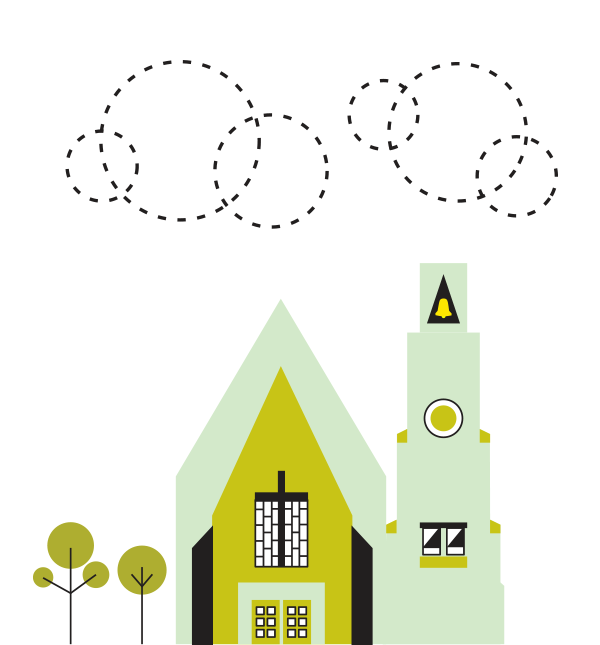
Next up for Doug is his most innovative project yet: a multi-use development of a century-old downtown church, which had been on the cusp of demolition. “We weren’t sure what to do with it, but we knew we wanted to save the building,” he says, noting that in six months he’ll be able to announce the new tenants.
What’s enormously gratifying to Doug is to see how the community has responded to his call to reimagine downtown. In the case of the church, attendance had waned from 1,000 members to 42, but there was another church just down the block. The churches now share one building, with one congregation holding Sunday services at 9, and the other at 11. Doug is seeing that spirit of cooperation and community building spread throughout the region.
Churches have historically been the central place for the community to come together spiritually. Recognizing the significance of the space in building community, Doug hopes the historic church will continue to serve as a central gathering place for the community with an entirely new purpose.
Higher utilization + Sharing facilities + Shared vision of a vibrant downtown
“Vibrant downtowns are the only way we’re going to attract a workforce, lower healthcare costs, and build an economically affordable city in the future. It’s places like the repurposed church where people come together to create that really enrich a community.

“We’re not the first group to try to retask a church. It’s a delicate, tough space to figure out, but that’s fun. It’s an interesting challenge.”
Doug loves a challenge, almost as much as he loves Fargo.
“I’m of the feeling that we’re just getting started.” What will he do next? He hopes you’ll visit Fargo and see for yourself.

Find more at livability.com + walkscore.com

Podcasts:
- Could the Next Brooklyn Be … Las Vegas?! Freakanomics
- The Gruen Effect 99% Invisible
- Evolving a City with David Sloan Wilson, On Being
Books:
- The Great Inversion and the Future of the American City by Alan Ehrenhalt
Review from Booklist: “In the future, American cities could look like late-nineteenth-century Vienna, with lively, affluent metropolitan core areas and the lower classes consigned to life in peripheral suburbs. Such cities will go well beyond gentrification and involve the displacement of the poor in inner-city areas by the wealthy, according to urbanologist Ehrenhalt. He details how the trend toward such cities is already apparent in Chicago, Atlanta, Washington, Houston, and other metropolitan areas. Drawing on census data and economic research, he examines the factors behind the trend, including mass transit, retail and housing development in downtown locations, and the declining appeal of long commutes to distant suburbs.” — Vanessa Bush
- The End of the Suburbs: Where the American Dream Is Moving by Leigh Gallagher
Review from Booklist: “Gallagher talked to homebuilders, developers, planners, transportation engineers, architects, psychologists, and home buyers and sellers in cities and suburbs to offer a fascinating portrait of housing and lifestyle trends. She examines how the American dream came to be tied to the suburbs even as they are lambasted in popular culture and by social scientists and, lately, planners and engineers. New Urbanists argue that the suburb is an unsustainable model because the low-density population doesn’t generate enough tax base to support it, unless it sprawls.” — Vanessa Bush
- Triumph of the City: How Our Greatest Invention Makes Us Richer, Smarter, Greener, Healthier, and Happier by Edward Glaeser
Glaeser travels through history and around the globe to reveal the hidden workings of cities and how they bring out the best in humankind.
Review from Booklist: Speck believes America has a problem—actually, lots of problems—that can be solved by improving walkability in our cities. Public health, sustainability, and even the lagging economy, he argues, can be boosted by making cities more friendly for pedestrians. Drawing on his background as a city planner and architectural designer, Speck lays out a 10-step plan for changing the way we build and think about our public spaces.”— Sarah Hunter
Articles:
- Tony Hsieh Is Building a Startup Paradise in Vegas by Susan Berfield
- The Link Between Walkable Neighborhoods and Race by Richard Florida
- Portland Downtown Plan Update Begins with Blueprint of 1972 as the Guide by Anna Griffin
- Gilbertville: A Billionaire’s Drive to Rebuild the Motor City by Joann Muller
- Gentrification in America Report by Mike Maciag
Event:
The Cities for Tomorrow conference will provide a dynamic environment for collaboration among industry decision makers who are working to create the future of our cities, including developers, architects, venture capitalists, city officials, government and urban policy professionals.
Websites:
- Springboard’s Creative Exchange A new national platform for storytelling and resource-sharing around artists, creativity and community.
- CityLab Through original reporting, sharp analysis, and visual storytelling, CityLab informs and inspires the people who are creating the cities of the future — and those who want to live there.
- Governing The nation’s leading media platform covering politics, policy, and management for state and local government leaders.
- Livability.com Explores what makes small-to-medium sized cities great places to live.
- Walkscore On a mission to promote walkable neighborhoods.
Contributors

